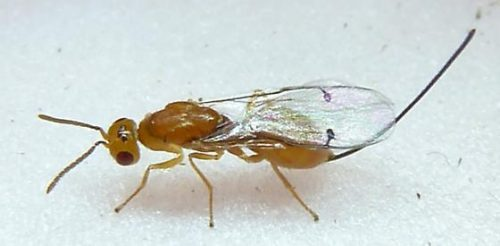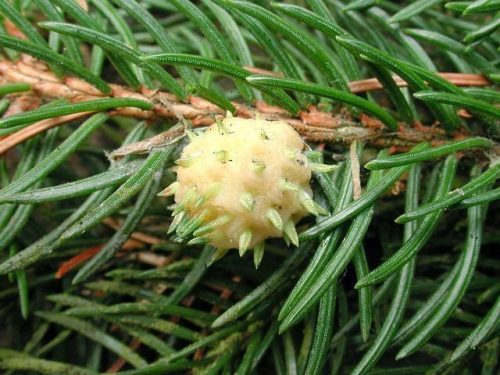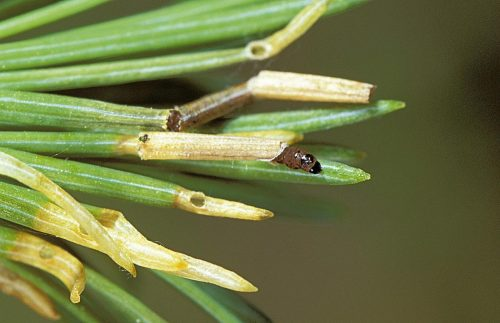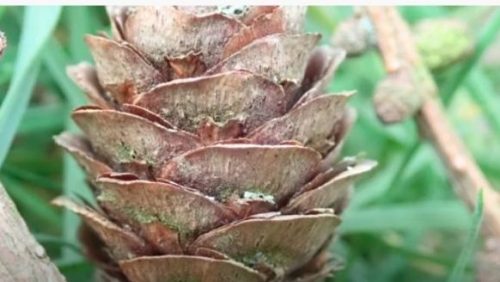Douglas fir and larch, pest information and treatment
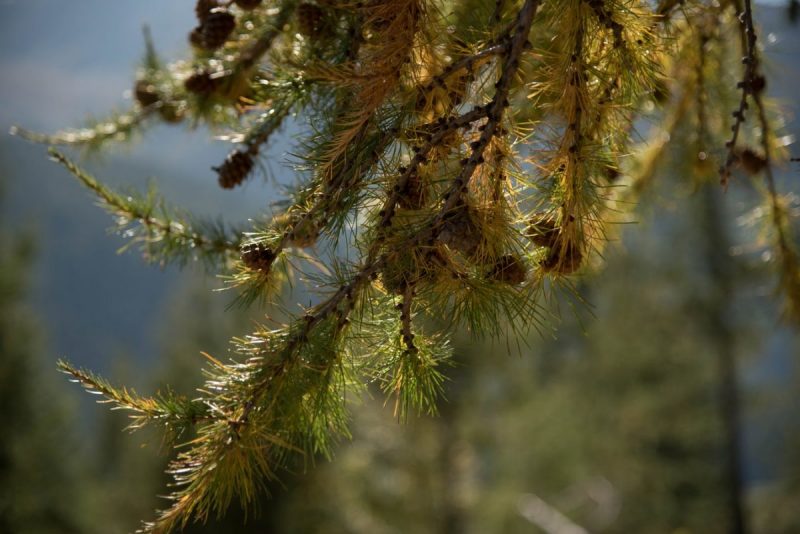
Worldwide, many insects can affect the health of these conifers. Douglas fir pests and larch pests produce damages to forest stands and to isolated trees from meadows, gardens, or parks.
Douglas fir pests
Megastigmus spermotrophus – douglas fir seed chalcid
It is a specific pest of douglas fir seeds, also known as the ‘douglas fir seed fly’, and found in all areas of cultivation of the species.
Biology. It has one generation per year. The flight occurs in May-June and the species overwinters in the larval stage, inside the infested seeds.
The attack. The females perforate the cone scales and lay their eggs in the green seeds. Young larvae feed on the contents of the seeds. Resin drops can be observed on the surface of the attacked cone. The round exit holes (about 0.6-0.8 mm in diameter) are visible on the surface of the attacked seeds.
Control methods. In order to prevent the mass multiplication of this pest, it is recommended to collect and destroy prematurely fallen cones. Surveys can be made of the seeds to be planted, in order to detect the presence of larvae in the seeds (by sectioning some of the seeds). It is recommended to apply chemical treatments (insecticides) only in case of outbreaks.
Recommended products
-
You can find products on a different store
Change Store -
You can find products on a different store
Change Store -
You can find products on a different store
Change Store -
You can find products on a different store
Change Store -
You can find products on a different store
Change Store -
You can find products on a different store
Change Store -
You can find products on a different store
Change Store -
You can find products on a different store
Change Store -
You can find products on a different store
Change Store -
You can find products on a different store
Change Store -
You can find products on a different store
Change Store -
You can find products on a different store
Change Store -
You can find products on a different store
Change Store -
You can find products on a different store
Change Store -
You can find products on a different store
Change Store -
You can find products on a different store
Change Store -
You can find products on a different store
Change Store -
You can find products on a different store
Change Store -
You can find products on a different store
Change Store -
You can find products on a different store
Change Store -
You can find products on a different store
Change Store -
You can find products on a different store
Change Store -
You can find products on a different store
Change Store -
You can find products on a different store
Change Store
Larch pests
Adelges laricis – woolly larch aphid
Adelgids usually attack more than one plant species. This larch pest infests spruce as a first host, after which it migrates on larch trees. It is a species widespread throughout the area occupied by larch trees, both in forests and in parks or gardens.
Biology. It usually has a generation every two years. Non-winged females overwinter at the base of trees or shrubs. In the spring, they migrate upwards on the tree trunks and finally lay eggs on the needles. The larvae overwinter on shoots.
The attack. The larvae produce green, round galls on the lateral shoots of spruce trees. Damage to larch is produced by the insects by stinging and sucking sap from the needles. The attacked larch needles turn yellow, break and fall prematurely.
Control methods. Avoid planting larch in association with spruce. In the event of an attack on small surfaces, the galls formed on spruce can be removed and destroyed manually. Chemical control is performed with the use of systemic or contact insecticides. Insect growth regulators can also be applied.
Recommended products
-
You can find products on a different store
Change Store -
You can find products on a different store
Change Store -
You can find products on a different store
Change Store -
You can find products on a different store
Change Store -
You can find products on a different store
Change Store -
You can find products on a different store
Change Store -
You can find products on a different store
Change Store -
You can find products on a different store
Change Store -
You can find products on a different store
Change Store -
You can find products on a different store
Change Store -
You can find products on a different store
Change Store -
You can find products on a different store
Change Store -
You can find products on a different store
Change Store -
You can find products on a different store
Change Store -
You can find products on a different store
Change Store -
You can find products on a different store
Change Store -
You can find products on a different store
Change Store -
You can find products on a different store
Change Store -
You can find products on a different store
Change Store -
You can find products on a different store
Change Store -
You can find products on a different store
Change Store -
You can find products on a different store
Change Store -
You can find products on a different store
Change Store -
You can find products on a different store
Change Store
Coleophora laricella – larch-mining case moth
It is also called the ‘larch leaf miner’ or the ‘larch case-bearer’. These larch pests are often identified in larch forests and on isolated larch trees, especially on 10-40 years old trees.
Biology. It has one generation a year, with the flight at the end of May. It overwinters in the larval stage, in cases formed by mining larch needles, in the cracks from the bark, or under lichens.
The attack. The larvae consume larch needles, frequently producing total defoliation. Damages are irreversible in nurseries or in young plantations. The attacked needles wither and turn white. The attack begins in the upper part of the crown and in case of a strong attack, the larvae descend on silk threads towards the lower parts of the crown.
Control methods. Pheromone traps are used to monitor the pest population and to control it. Chemical treatments with contact insecticides can be applied during the flight or in the larval stage (especially in early spring).
Recommended products
-
You can find products on a different store
Change Store -
You can find products on a different store
Change Store -
You can find products on a different store
Change Store -
You can find products on a different store
Change Store -
You can find products on a different store
Change Store -
You can find products on a different store
Change Store -
You can find products on a different store
Change Store -
You can find products on a different store
Change Store -
You can find products on a different store
Change Store -
You can find products on a different store
Change Store -
You can find products on a different store
Change Store -
You can find products on a different store
Change Store -
You can find products on a different store
Change Store -
You can find products on a different store
Change Store -
You can find products on a different store
Change Store -
You can find products on a different store
Change Store -
You can find products on a different store
Change Store -
You can find products on a different store
Change Store -
You can find products on a different store
Change Store -
You can find products on a different store
Change Store -
You can find products on a different store
Change Store -
You can find products on a different store
Change Store -
You can find products on a different store
Change Store -
You can find products on a different store
Change Store
Strobilomyia laricicola
Pests are found mainly at high altitudes, where they prefer well-lit, isolated trees. Damages are produced to larch cones, sometimes to spruce cones. In case of an outbreak, up to 75% of the seed production can be destroyed.
Biology. The insect has one generation per year and overwinters in the larval stage, in a characteristic cocoon, in the surface layer of the soil.
The attack. The larva enters the cone through a small, round hole. The attacked cones deform and resin-leakages appear on their surface. In the axis of the sectioned cone, there is a longitudinal gallery full of yellow, liquid excrements.
Control methods. Mechanical control can be performed, by gathering and destroying the prematurely fallen cones. Contact insecticide treatments can be applied to the soil surface before the larvae migrate for overwintering. Contact insecticides may be applied during the flight. These larch pests have many natural predators and parasites that need to be protected.
Recommended products
-
You can find products on a different store
Change Store -
You can find products on a different store
Change Store -
You can find products on a different store
Change Store -
You can find products on a different store
Change Store -
You can find products on a different store
Change Store -
You can find products on a different store
Change Store -
You can find products on a different store
Change Store -
You can find products on a different store
Change Store -
You can find products on a different store
Change Store -
You can find products on a different store
Change Store -
You can find products on a different store
Change Store -
You can find products on a different store
Change Store -
You can find products on a different store
Change Store -
You can find products on a different store
Change Store -
You can find products on a different store
Change Store -
You can find products on a different store
Change Store -
You can find products on a different store
Change Store -
You can find products on a different store
Change Store -
You can find products on a different store
Change Store -
You can find products on a different store
Change Store -
You can find products on a different store
Change Store -
You can find products on a different store
Change Store -
You can find products on a different store
Change Store -
You can find products on a different store
Change Store
Ips cembrae – large larch bark beetle
It causes damage by forming galleries under the bark of larch species. Damages are also found on pine (especially Swiss pine) and spruce trees. This insect prefers trees with poor vegetation, healthy trees are less often attacked.
Biology. It has 1-2 generations per year, with the flight in May-June and August. It overwinters in the adult stage, under the bark, or in the litter.
The attack. The females chew 5-17 cm long mother-galleries under the thick bark of the trees. Most often, 3 mother galleries start from one nuptial chamber, two in one direction, and another one in the opposite direction. Many larval galleries can be identified, starting from the mother galleries. At the end of each larval galley, a pupation spot can be observed, which is deep in the bark.
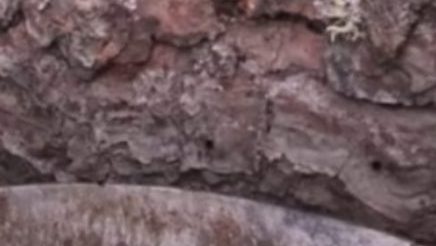
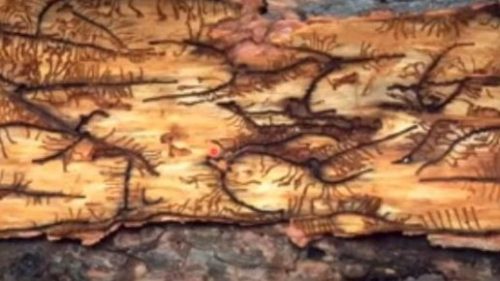
Control methods. It is recommended to detect in time the mass multiplication of these larch pests, through observations on each stage of development (eggs, larvae, adults). The round entrance holes under the bark can be observed, as well as the flight holes. Pheromone-baited and chemically treated trap logs can also be used for monitoring and control. Insecticides can also be used.
Recommended products
-
You can find products on a different store
Change Store -
You can find products on a different store
Change Store -
You can find products on a different store
Change Store -
You can find products on a different store
Change Store -
You can find products on a different store
Change Store -
You can find products on a different store
Change Store -
You can find products on a different store
Change Store -
You can find products on a different store
Change Store -
You can find products on a different store
Change Store -
You can find products on a different store
Change Store -
You can find products on a different store
Change Store -
You can find products on a different store
Change Store -
You can find products on a different store
Change Store -
You can find products on a different store
Change Store -
You can find products on a different store
Change Store -
You can find products on a different store
Change Store -
You can find products on a different store
Change Store -
You can find products on a different store
Change Store -
You can find products on a different store
Change Store -
You can find products on a different store
Change Store -
You can find products on a different store
Change Store -
You can find products on a different store
Change Store -
You can find products on a different store
Change Store -
You can find products on a different store
Change Store














































































































































































































































































































































































































































